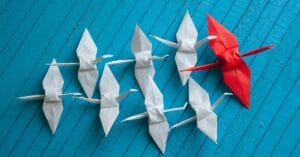In his 1981 book Management Teams: Why They Succeed or Fail, researcher and consultant Meredith Belbin outlines a number of common roles that can be observed in teams at work.
By taking into account each of these roles and how they interact with one another, leaders and managers can use Belbin’s model to make better decisions and build more resilient and successful teams.
Listen to this article on TSW’s skills development podcast, Learn Practice Perform.
Belbin’s nine team roles explained
Belbin defines nine team roles that individuals may perform when working together.
These roles can be categorised into three groups:
- Action-oriented roles
- People-oriented roles
- Thought-oriented roles
Here’s a brief description of each team role from Belbin’s model, including the strengths and weaknesses commonly associated with each role.
Action oriented-roles
Shaper: This role is usually fulfilled by extroverts who are confident in challenging other members of the team to improve. Shapers don’t mind questioning the status quo to find the best solutions to problems and embrace the chance to shake things up.
- Strengths: Problem solving, ambition
- Weaknesses: Potential to cause friction
Implementer: The implementer is a doer: someone who doesn’t mind getting their head down and working hard to complete the task that’s been set for them. They thrive when turning plans into action, using methodical systems to get the job done efficiently.
- Strengths: Task completion, dedication
- Weaknesses: Resistant to change
Completer-finisher: Perfectionists by nature, completer-finishers are the gatekeepers of quality within a team, ensuring that each job is completed in a timely and professional manner. They’re meticulous about avoiding error, and sticklers for meeting deadlines.
- Strengths: Meeting deadlines, quality assurance
- Weaknesses: Over-worrying, reluctant to delegate
People-oriented roles
Coordinator: The role of coordinator is similar to that of a traditional leader. With a strong grasp of the team’s overall goals and a talent for delegating tasks to the right people, coordinators guide their team toward the objective in a controlled and proficient way.
- Strengths: Project management, effective delegation
- Weaknesses: Avoiding responsibility
Team worker: A catalyst for collaboration and unity within groups, the team worker excels in helping colleagues to overcome differences and avoid conflict while striving towards a common goal. Their mission to create a supportive work environment means team workers are often popular figures.
- Strengths: Perceptiveness, mediation
- Weaknesses: Indecisiveness
Resource investigator: This role is associated with people who find it easy to build contacts and get what they need from others. Resource investigators are often extroverts and adept negotiators who work with external suppliers to achieve great results for their team.
- Strengths: Wealth of contacts, negotiation
- Weaknesses: Overly optimistic
Thought-oriented roles
Plant: Plants produce interesting and original ideas for the benefit of the team. They’re typically introverted, preferring to work alone when developing new ideas and coming up with solutions to problems.
- Strengths: Creativity, innovation
- Weaknesses: Sensitive to criticism, may ignore constraints
Monitor-evaluator: Thoroughly analysing and strategically evaluating ideas is the monitor-evaluator’s calling. They enjoy gathering data and evidence to consider the advantages and disadvantages of every option.
- Strengths: Analysis, strategy
- Weaknesses: Poor leadership
Specialist: A master in their chosen field, the specialist prides themselves on their knowledge and expertise in a given subject area. They use their specialism to aid the team, acting as the authority on all technical and practical considerations relating to their topic.
- Strengths: Subject-specific expertise
- Weaknesses: Too focused on technicalities
How can leaders and managers use Belbin’s team roles to improve performance?
Leaders and managers can use Belbin’s model to create balanced teams with a complementary mix of personalities and skills to fulfil the different roles described above.
In smaller teams, each individual may need to adopt several roles for the team to achieve optimal results.
Take stock of the people within your team, their personalities and skills. What can each team member bring to the table, and which roles might suit them best?
For example, let’s say your team includes:
- Alex, a detail-obsessed extrovert who’s good at thinking outside the box
- Janette, an organised leader who gets along with everyone
- Hussein, an IT expert with an analytical mind
- Dee, a quiet creative whose ideas have previously won major contracts
- Edmond, a well-connected and diligent worker
Between them, these five personalities can potentially cover all nine of Belbin’s team roles:
- Alex: Shaper, completer-finisher
- Janette: Coordinator, team worker
- Hussein: Monitor-evaluator, specialist
- Dee: Plant
- Edmond: Implementer, resource investigator
A team like this has all the skills and assets required to be successful, but will still need to be managed effectively in order to achieve great results.
For example, a good manager might choose to give an introverted plant like Dee space to shape her ideas away from the group, rather than subjecting her to critical thinkers like shaper Alex and monitor-evaluator Hussein before her creative concepts are fully realised.
A resource investigator and implementer like Edmond might require a flexible schedule, giving him time in and out of the office to balance external connections with project work. Meanwhile, coordinator and team worker Janette will need regular contact with all her colleagues to oversee the project and ensure that everyone is working towards the same goal.
In a smaller team where not all of Belbin’s team roles can be fulfilled, think carefully about which roles should be prioritised over others. If a task follows logical systems with no need for creative input, a plant and shaper may not be required – you might instead place emphasis on practical roles like specialist, implementer and coordinator.
Even with a balanced team, there are a number of things that teams need to contend with to perform to their potential. Take a look at our blog on Patrick Lencioni’s Five Dysfunctions of a Team to see if your team has any of these barriers to progress.
Advantages and disadvantages of Belbin’s team roles
Belbin’s team roles provide a useful model for maximising the performance of teams. By considering the strengths and weaknesses of each individual, leaders can organise their teams in a way that utilises everyone’s talents and fosters productive, creative collaboration.
There are, however, some limitations to this model. The roles outlined by Belbin are primarily concerned with collaborative work, and don’t necessarily describe how individuals perform on independent projects. Nor do team roles necessarily reflect an individual’s personality outside the context of a team.
It’s therefore wise to use other theories alongside Belbin’s when making important decisions as leaders and managers, such as Maslow’s Hierarchy Of Needs, Eisenhower’s Matrix or Six Thinking Hats.







